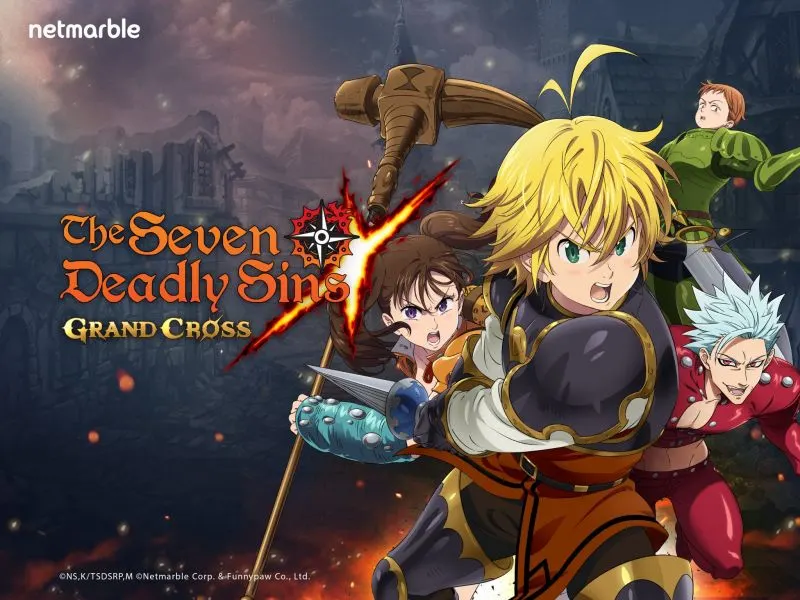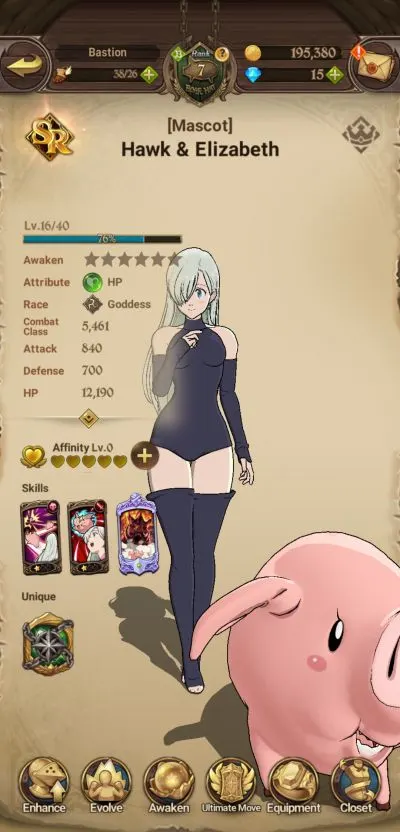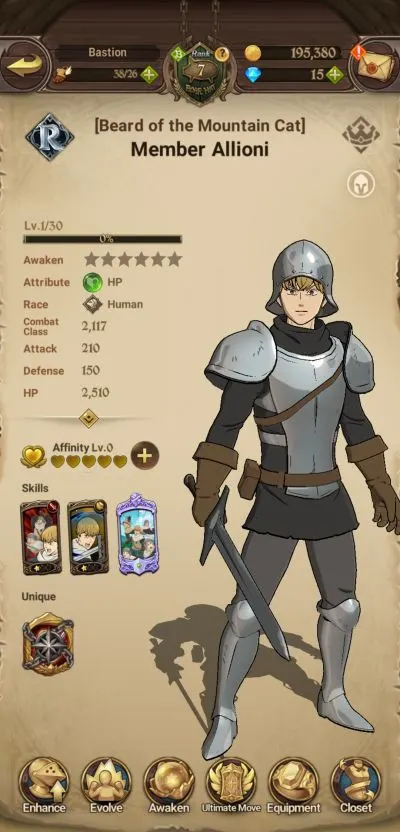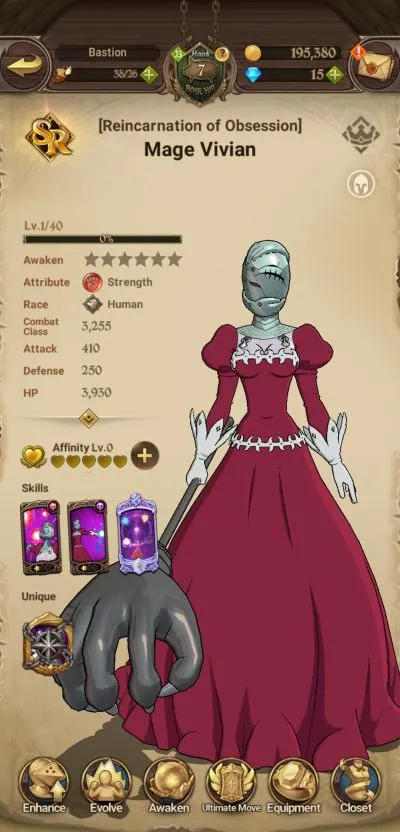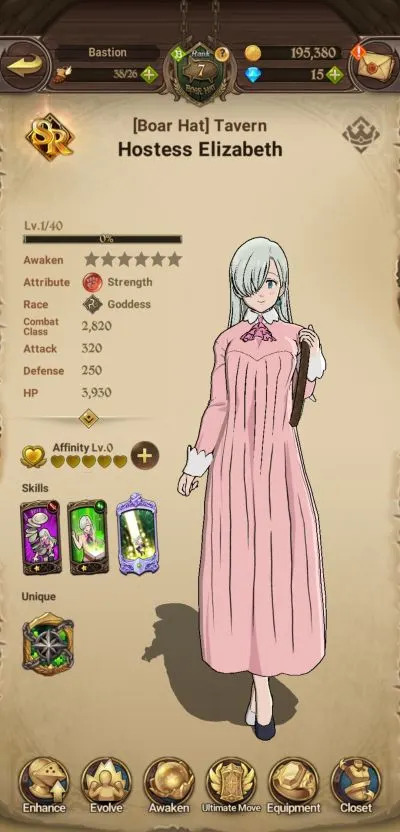The Seven Deadly Sins: Grand Cross continues to stay strong a few weeks after its global launch. Amassing well over a million downloads from the Google Play Store alone and maintaining its superb average user review rating, The Seven Deadly Sins: Grand Cross remains as the top new game in numerous countries where it was launched and quickly climbed the ranks on the Apple App Store as well.
Considering the overabundance of RPGs available on mobile, and the existence of similarly popular titles that came ahead of it, The Seven Deadly Sins: Grand Cross has proven well enough that it can attract and draw in a lot of players with the entirety of what it has to offer.
Beyond the overall quality of its visuals and several unique features new even to veteran RPG enthusiasts, The Seven Deadly Sins: Grand Cross’ overall charm is also due to the way players can customize the characters and teams at their disposal. While naturally, some units are built to be better than others, even considering the deemed less powerful units can still provide a fun and engaging combat experience.
If you have just started playing The Seven Deadly Sins: Grand Cross or have just heard about it and plan on playing, be sure to read our beginner’s guide as it offers all the basic tips and strategies you need to jumpstart your adventure. There are certainly a lot of content to peer through but in this guide, we will be focusing on the various classes.
Although characters in The Seven Deadly Sins: Grand Cross have a lot of unique classifications each one falls within, as well as distinct abilities that are borne of links and associations, one conventional RPG element that seems missing is the class system that determines each one’s role. However, team strategies in any RPG work around the variety of abilities and skill sets each unit possesses and even in The Seven Deadly Sins: Grand Cross, it is necessary to determine early on each unit’s role to see how well they fit and synergize with the rest of the team.
In this sense, as skills in the game are categorized under 6 main types, we can more or less depict each one’s role based on their skill sets. These would be Attack Skills, Buff Skills, Stance Skills, Debuff Skills, Debuff Attack Skills, and Recovery Skills.
Attack skills are all about dealing damage and whether the attack targets a single enemy or has an AoE effect, both are categorized under this skill type. Buff skills are, by nature, abilities that affect the unit or the entire team with stat boosts or other positive effects for a set number of turns. Stance skills are essentially unique and will probably be new even to veteran RPG enthusiasts.
These skills place the unit in a specific stance that causes various effects that trigger immediately or when attacked. Debuff skills are the polar opposite of buff skills and these skills are characterized by the imposition of negative status effects on an enemy unit or units. Debuff attack skills are just a hybrid of both skill types as these skills deal great damage as well as inflict negative status effects. Last, but definitely not the least, are Recovery skills all aimed towards healing and HP restoration for the team.
Naturally, though, most units in The Seven Deadly Sins: Grand Cross exhibit different skill types hardly leaving anyone with a full set of skills under the same type. Given that one of the game’s unique features lie in the skill card system that enables cards to be fused for even more potent effects, some of these skills change its type after being ranked up in combat. Despite the wide variety of possible skill combinations each unit may have, categorizing each one under classes or roles is still possible based on their more dominant skills and sometimes even with just the existence of one skill type. With the given skill types in The Seven Deadly Sins: Grand Cross, we can consider categorize characters under 4 major classes or roles: Attackers or DPS, Tanks, Supports, and Healers.
Attackers / DPS Characters
In relation with the conventional roles present in any other RPG, attackers or DPS characters have almost always taken the spotlight in tier lists and top character choices. As the main damage-dealers in parties, attackers are relied on to deal the most damage to enemy mobs or enemy bosses in case of dungeons and boss battles.
In The Seven Deadly Sins: Grand Cross, the most basic skill type is the attack skill, symbolized the sword icon. Most characters have attack skills although each one has different effects. In essence some characters who have attack debuff skills can still be considered as an attacker, especially if the unit is primarily considered for the team because of his or her high damage outputs.
As an example, one of the first characters to join you in your adventure, SR [Mascot] Hawk & Elizabeth, is a decent attacker and is considered as one of the best AoE characters in the game at present. Her first skill, Super Pork Loin Illusion, which is an attack debuff skill, inflicts damage equal to 180% of attack on one enemy and reduces defense-related stats by 20%. Skill card fusion leaves the skill with higher damage and a larger percentage of defense stat-reduction. Hawk & Elizabeth’s second skill, Super Hawk Illusion, which is an attack skill, inflicts pierce damage equal to 100% of attack on all enemies. Fusion enables this skill to deal even more damage.
Another good example of an attacker is the main protagonist SR [Boar Hat] Tavern Master Meliodas, whose Triple Attack skill inflicts weak point damage equal to 110% of attack on one enemy and has increased damage when the skill cards are combined. Though his secondary skill, Full Counter, is a stance skill, it deals reactive damage to enemies that attack him whenever his stance is active.
Tanks
Tanks are not a common role in The Seven Deadly Sins: Grand Cross given that the requisites and scenarios needed for characters to be able to tank properly are hardly available in the game. For starters, there is no front line or back line in the battle formation, which leaves every unit equally vulnerable to attacks. Provocation is perhaps the only skill in the game that enables a character to attract more attackers to him or her. Some characters with stance skills can provoke enemies and these are the units that can serve as tanks in combat.
SSR [Thunderbolt] Guardian Gilthunder is an example of a decent tank. His second skill, Lightning King’s Heavy Armor, is a stance skill that taunts enemies and reduces the damage he takes by 30% for a turn. Damage reduction and turns within which the skill takes effect increases when skill cards are combined. His primary skill, Lightning Beasts Chase, is an AoE attack and debuff skill that deals 80% damage to all enemies and deals shock as well. Damage and turns of effectiveness also increase with each card combination.
Further down the rarity line, R [Beard of the Mountain Cat] Member Allioni also sports the same stance ability that provokes enemies to attack him. “Ah! Emergency!” does that for a turn or two, if fully upgraded, and comes with an increasing percentage of damage reduction as well. His primary skill, though, “Charge Forward!”, is a basic single target attack skill that inflicts shatter damage equal to 180% of his attack.
Support Characters
Now the support class, as a role or unit category, can be as vague as to consider everyone else who is neither an attacker nor a defender. While units that specialize in boosting the team’s overall effectiveness with buffs or inflicting various negative status effects on enemy units always fall within the support types, we distinctively choose to consider healing and recovery as a separate class for purposes of establishing its separate significance to the functions of other support class units.
There are various status affects available in The Seven Deadly Sins: Grand Cross and these can be activated by different skills within the numerous buff skills, debuff skills, and debuff attack skills that some characters possess. Again, characters that have debuff attack skills can be considered both as an attacker and a support character but considering everything, some are naturally better at inflicting raw damage while others swerve more towards the added effects of their skills.
A great example of a top-notch support character in the game is SSR [Camelot’s Sword] New King Arthur, one of the fan-favorites and a common consideration for the top tier candidates. This version of Arthur has both a debuff and buff skill that comes in handy in numerous situations. To start off, Light Pillar is a simple attack skill that deals 220% of attack against one enemy but when fused, the skill can disable recovery skills, making him a threatening adversary in PvP. His second skill, Royal Sword, initially boosts the basic stats of an ally by 20% and combined with the same skill card, can affect all allies along with debuff removal and debuff immunity at top rank.
Another example of a support type character is SR [Reincarnation of Obsession] Mage Vivian. Darkness Bolt, her primary skill deals damage amounting to 180% of her attack and inflicts ignite, which boosts damage received by the enemy, for 3 full turns. Since ignite is stackable, the damage she deals, ignite effects, and number of effective turns all grow with each card fusion. Mage Vivian’s second skill, Freeze Coffin, can debilitate enemies even further by taking away their ability to use ultimate moves for 1 to 3 turns.
Healers
As an integral part of most team compositions in practically every RPG that involves team combat, healers are often the least favorite of class types given their usual low offensive strength and often coupled with subpar defensive strength as well. Healers, however, have an unquestionable value regardless of whether it is a PvE or PvP scenario. While there are a number of support skills that help keep the entire party alive, whether through bolstering the allies’ stats or diminishing the opposition’s. Healers are exclusively built for keeping the team alive and are a more basic necessity to any team, than any type of support unit.
Although you can win battles, especially short ones, in The Seven Deadly Sins: Grand Cross without the aid of any healer type character, it will be easier to build a team around one, especially on more challenging ordeals and enemies.
While there are no units in the game that showcase a full set of abilities dedicated to healing and recovery, there are several characters who are definitely going to be popular picks for a lot of teams due to their recovery skill. One of these units is a character everyone probably has, SR [Boar Hat Tavern] Hostess Elizabeth. This version of Elizabeth has Nurse Call, as a secondary skill, which heals HP of all allies amounting to 200% of her attack. Merging it further will enable the skill to also fill ultimate move gauges with 1 to 2 orbs.
What makes Elizabeth valuable is her primary skill in combination with her ability to heal teammates. Slide Serve initially deals damage to an enemy unit equal to 220% of attack. Merging it even once, unlocks a terrifyingly distasteful debuff that disables the target’s attack skills for a turn.
Yet another popular healer who also serves as a support type unit is SSR [The Grizzly Sin of Sloth] King whose ability to heal as well as control skill, can really help your team in most scenarios. This version of King’s second skill, Spirit Spear Chastiefol, Eight Form: Pollen Garden, initially can only remove debuffs from all allies. Once upgraded through merging, though, it comes with a 30% to 50% healing on top of removing all debuffs. King’s primary skill is likewise highly coveted as Spirit Spear Chastiefol, Third Form: Fossilization, can petrify an enemy for 1 to 2 turns after being merged.
Some units in the game have recovery skills that may not necessarily end with a one-time healing. There is a rejuvenate status effect that works very much like the conventional HP regen in other RPGs. For now, though, we have only seen it as an added effect of SR [Omen of Chaos] Hendrickson’s Purge skill but there may still be unreleased characters or units later on who can also exhibit the same effect.
There are numerous other skills in The Seven Deadly Sins: Grand Cross that should impact how you choose which ones to consider for your team and with the game’s massive story content, PvP, raids, and other game modes, there will certainly be dominant teams that may specialize in one aspect of the game yet do relatively poorly on another. As you have limited resources to invest in the characters you obtain through your adventure, learn to build the most suitable team for different situations based on the role that each character can play.
Note that you do not necessarily have to follow a particular combination of classes or roles to do well in each game mode. What matters is that the characters synergize enough to do well not just on their own, but with the entire team as well.
In addition to distinguishing characters in The Seven Deadly Sins: Grand Cross through the different classes or roles they belong to, there are also numerous other character-centric features in the game to consider as you build your very own team. Attributes, races, and associations all has its impact on the units performance in combat. While attributes follow the “rock-paper-scissors’ method of dealing and receiving damage in battle, races are a little less significant in the sense that only select unique traits of certain heroes have effects that impact certain race types.
Associations, however, can be a crucial deciding factor especially if you are choosing between or among some characters as to which ones to take with you in battle. Associations can lead to enhanced stats between paired characters and may even unlock a combined attack that takes precedence over an ultimate skill. You may not have the luxury of building around linking characters early on due to the limitations of your roster but as you continue to make progress, these associations, along with the right class considerations in mind, can help you build a powerful team.
The Seven Deadly Sins: Grand Cross is certainly filled with a lot of features to discuss and strategize around but for now, this is where we end our class guide. Hopefully, the information that we shared has helped you have a better perspective on how to build your teams based on the class and roles that each of your units have. If you need further guidance in this topic or simply want to share your thoughts on the game, don’t hesitate to do so and drop us a note in the comments!

